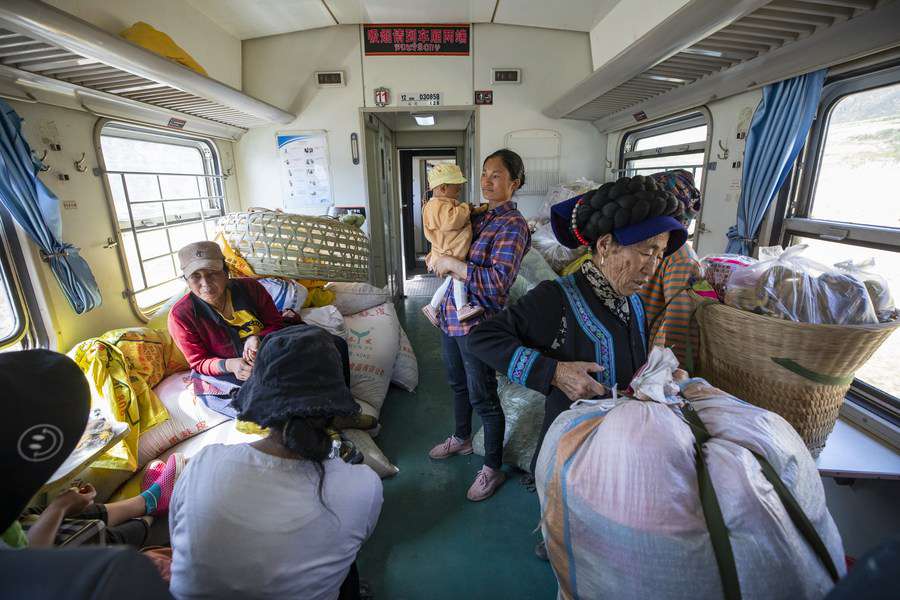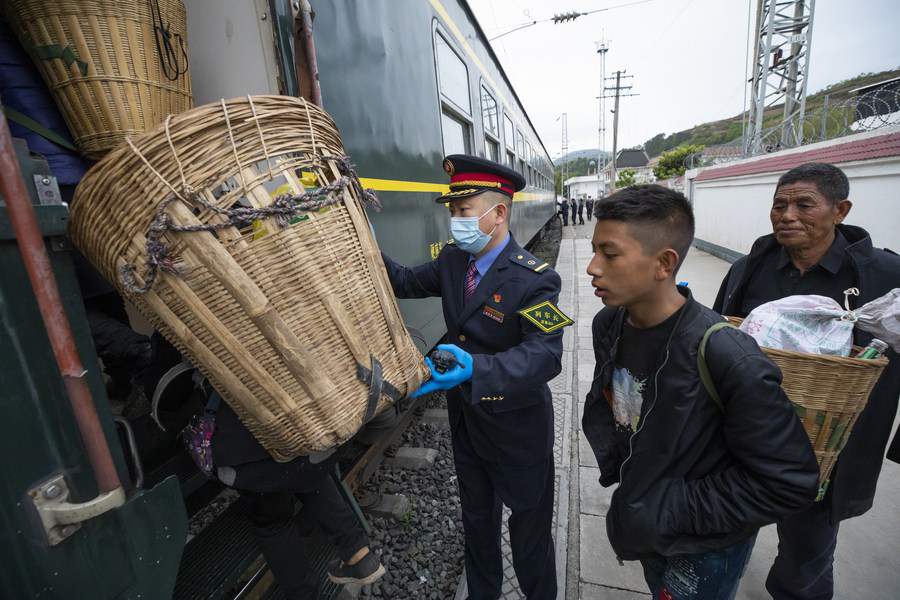Slow trains bear witness to life changes in southwest China
-- Though home to the world's most developed high-speed railway network, China still regularly operates 81 slow train services, covering 35 ethnic minority-populated regions, transporting some 12 million people annually at an average cost of no more than 0.06 yuan per km.
-- Slow train service has been operating in Liangshan Yi Autonomous Prefecture, southwest China's Sichuan Province, for over half a century, becoming a lifeline for generations of local people.
CHENGDU, April 27 (Xinhua) -- In an age of ever-extending high-speed rail networks and a race for efficiency, slow trains with an average speed of less than 40 km per hour are still running in the mountains and deserts in remote corners of China.
The slow trains, carrying the hope of local people, move forward steadily and surely with a unique rhythm that has not changed for more than 50 years.
OLD FRIENDS FOR HALF CENTURY
Layi Axia, 75, a Yi ethnic from Mianshan Township in Liangshan Yi Autonomous Prefecture, Sichuan Province, remembered the day a train first rolled into Mianshan railway station. She and her husband took their one-year-old son and walked 7 km to see it.
"The train body was decorated with small red flags. We waved to the passengers, and they waved back," she said. "It was the most unforgettable day in my life."
She was still a newlywed when the Chengdu-Kunming Railway, a major transportation artery linking southwest China's Sichuan and Yunnan provinces, opened in 1970.
Her husband, a former soldier, took good care of her. They spent many hours toiling in the fields and keeping busy with farmwork in order to support their family. Later her husband died of illness, leaving her and three young sons behind. She struggled for years until, at 53, her children were married and she finally had a life of her own.

Layi Axia, a 75-year-old woman of Yi ethnic group, takes the 5634 train home with replenished shop stock bought from a wholesale market in Xichang in southwest China's Sichuan Province, April 12, 2021. (Xinhua/Shen Bohan)
She runs a small shop in Mianshan, selling hairpins, binding strings, hats, socks and the like. She takes the slow train to replenish her stock at a wholesale market in Xichang, the capital city of the prefecture, and goes to Sunday fairs. Business is slow, but she makes enough to cover household spending and beat loneliness.
Over the past half-century, trains running on the Chengdu-Kunming Railway have been speeding up with the development of national strength. The slow trains have also changed -- coal is no longer burned for power and the seats are much more comfortable.
However, the 5633/5634 train running between Puxiong Township and Panzhihua city still maintains its initial speed at an average of less than 40 km per hour. The whole journey is 376 km, with 26 stops along the way. The entire journey takes 11 hours and 4 minutes. The highest fare is 25.5 yuan (about 3.9 U.S. dollars), and the lowest fare is 2 yuan. The fares have remained unchanged for more than 30 years.
The wholesale price of potatoes, one of the most transported products on the train, has increased tenfold in the past 30 years.
TRAIN OF LIFE
Liu Wei, 46, has been working on the slow train for 28 years.
His father retired from the army and was dispatched to Tiexi Station along the Chengdu-Kunming Railway in 1968, becoming the only clinic doctor in the vast area.

Women of Yi ethnic group take the 5634 train in southwest China's Sichuan Province, April 12, 2021. (Xinhua/Shen Bohan)
"The time at the small station is too lonely. For the employees, families and children at the station, the most important thing every day was to go to the platform after dinner and wait for the slow train to arrive." Liu said only the sound of the train siren could cut through the loneliness and wake up the drowsy people.
The slow train is a cure for the tediousness of life, bringing stories from the outside as well as strange faces. Every time the slow train pulls into the station, workers, the old, children and dogs all stood together on the platform. The train only stayed for two minutes, but it was enough to wash away people's tiredness and loneliness.
Liu went to school by train every day. In the carriage, he listened to passengers discuss current affairs, watched peddlers bargain and observed train attendants. In his eyes, the attendant uniform was the most handsome outfit he could think of. His mother always carried potatoes and apples to sell. Several times, she almost was not able to make it on the train because she was carrying too much on her back.
He had looked forward to growing up so that he could help his mother carry heavy loads and put on the polished attendant uniform.
As soon as he graduated from middle school, he got his wish and became a train attendant."When I see children, I see what I used to be. When I see the old selling things, I see my mother," he said.
Liu recalled an old lady who used to get on at Puxiong Station every day, carrying potatoes collected from fellow villagers to Ganluo for sale, sometimes carrying more than 200 kg with the help of others.

Little passengers look out of the 5633 train in southwest China's Sichuan Province, April 11, 2021. (Xinhua/Xu Bingjie)
For seven to eight years, she always took the same carriage and sat in the same seat. Liu often chatted with her. It turned out that her husband died early in their marriage, and she had to bring up four children by herself. The children grew up and left the mountains. The old lady still carried potatoes day after day, even though she was in her 70s.
One day, she did not get on the train. Liu asked other passengers and was told that she had passed away. Though he did not know her name, Liu felt like he lost a relative.
There is life that leaves, and there is also life that comes.
Once a baby boy was abandoned in a toilet of the train as soon as he was born but was fortunately adopted by a lady on the same train. Five years later, the old lady found Liu on the train, pointing to the child next to her and said: This is the boy from the toilet.
"At that moment, I suddenly felt that I was working on the train of life," he said.
Over the years, at least seven or eight children were born on Liu's train, and some Yi villagers even named their children "manche," meaning "slow train" in Chinese.
TRAIN TO THE FUTURE
Asu Ershi, 45, is a vice principal at a high school in Xide County along the railway. He had grown up counting the carriages of slow trains, and his favorite game was to make a train out of pebbles.

Chief conductor Liu Wei (L) helps a passenger board the 5633 train at Puxiong station in southwest China's Sichuan Province, April 11, 2021. (Xinhua/Shen Bohan)
In 1987, he and his childhood friends were finally old enough to take the slow train to school, and on the train, they, for the first time, heard adults talk about Chengdu and Chongqing -- the big outside world.
At the boarding school where Asu Ershi works, every two weeks, more than 700 students take the 5633/5634 train home and back to school. In the days when he went to school, girls were rarely seen on the train. But today, girls make up two-thirds of students.
People are dressing more fashionably, fewer are drinking on trains and you rarely see teenage brides, who were commonly seen taking the train to their husband's hometown to get married.
Outside the carriage window, more changes have taken place: buildings and vegetable greenhouses have "grown" in the once barren land; preschoolers are sent to kindergartens; young people who left the mountains have returned with confidence and ambition.
Though home to the world's most developed high-speed railway network, China still regularly operates 81 slow train services, covering 35 ethnic minority-populated regions, transporting some 12 million people annually at an average cost of no more than 0.06 yuan per km.
In order to ensure that these slow trains come to the people rain or shine, the Chinese government gives big subsidies every year. Not only that, but it also makes huge investments in upgrading the stations and building roads along the railways.
"No matter how much the world changes and how fast the high-speed rail is, the slow train is still some people's lifeline," Liu said. "My mission is to do my job well, which has nothing to do with the speed of the train.
Photos
Related Stories
Copyright © 2021 People's Daily Online. All Rights Reserved.










